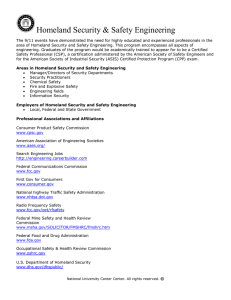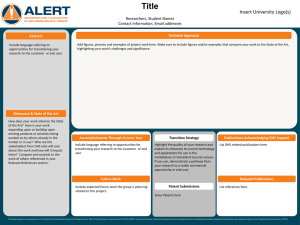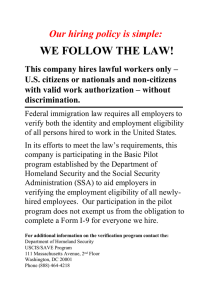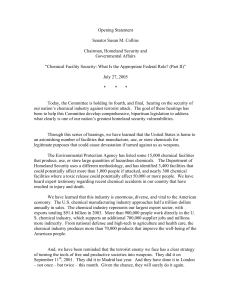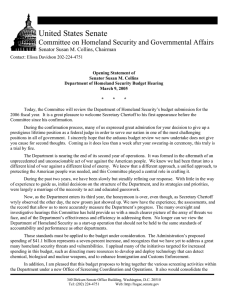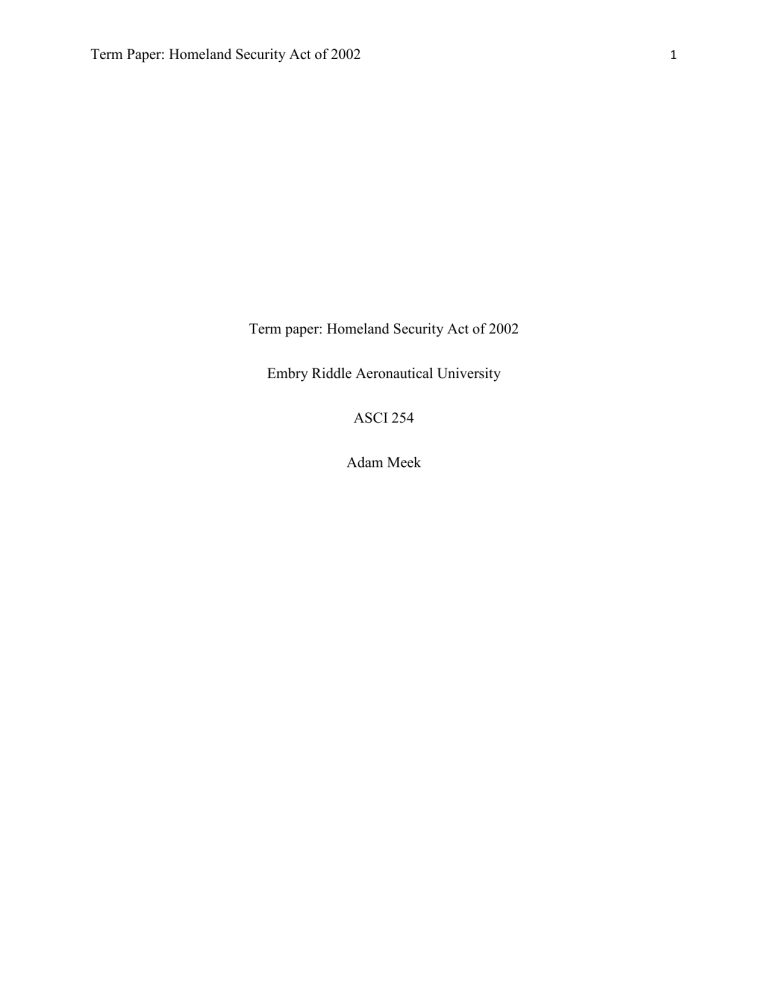
Term Paper: Homeland Security Act of 2002 Term paper: Homeland Security Act of 2002 Embry Riddle Aeronautical University ASCI 254 Adam Meek 1 Term Paper: Homeland Security Act of 2002 2 Introduction The events that occurred on September 11, 2001 were tragic. Thousands of people lost their lives including the passengers on the hijacked airplanes, the firefighters and the policemen as well as those who were surrounded by the World Trade Centers when they collapsed. The events that occurred caused a lot of changes such as the establishment of the Department of Homeland Security. The government wanted to introduce a new Cabinet level into the Executive Branch, which was solely in charge of overseeing the security of our nation. Congress passed the Homeland Security Act in 2002 and it was signed by former President George W. Bush. As a result, the Department of Homeland Security was established on November 25, 2002 (Lawrence, 2015). According to the book, Aviation & The Role of Government written by Harry Lawrence, “The primary mission of the Department is preventing terrorist’s attacks in the United States, reducing the Country’s vulnerability to terrorism, and minimizing damage in the event such attacks occur”. The Mission The mission of the Department of Homeland Security is, “to ensure a homeland that is safe, secure, and resilient against terrorism and other hazards” (Lawrence, 2015). They oversee all domestic issues involving terrorism and possible threats to the safety of our nation by working in all aspects of the country, including aviation and ground transport as well as military relations. At any given time, they have more than 240,000 employees working day and night by means of air, land, sea or space to keep our borders safe from possible insider threats (DHS, 2017). The Department of Homeland Security plays a huge role in the safety of our nation. Ever since the establishment of the Department of Homeland Security, they have been credited with thwarting over fifty possible terrorist attacks in the United States (Bucci, N.D). The Homeland Term Paper: Homeland Security Act of 2002 3 Security Act of 2002 combined multiple federal agencies allowing them to work side by side and ensuring the safety of our nation. A few key agencies involved include TSA, Customs and Border Protection (CBT), FEMA, National Guard and more. They monitor all existing agencies, smoothly connecting them and ensuring that they are communicating with one another in order to better secure our borders (Congress, N.D). The Act The Homeland Security Act of 2002 provided a lot of changes in regards to our nations’ security. One key change which occurred was that the act allowed for training of airline pilots to handle firearms in the cockpit as an added security measure (Lawrence, 2015). This is a pretty serious addition since firearms are banned on airplanes. The first forty-four airline pilots certified as Federal Flight Deck Officers graduated from the Federal Law Enforcement Center in Glynco, Georgia in 2003 (Lawrence, 2015). Another key change that the Homeland Security Act of 2002 caused was the Presidential Determination No. 01-29. This determination allowed for the issuance of war risk coverages to U.S flag carrier airplanes. Before the Act was introduced, airlines didn’t receive coverage from damages caused during war, sabotage, civil unrest, or terrorism. Typically, third party liability insurances would not cover airlines prior to September 11th. After September 11th, the war risk insurance became prohibitively expensive to obtain thus creating the Presidential Determination No. 01-29. Another development brought on by the Homeland Security Act of 2002 is the creation of a coding scale used to rate the potential of terrorism present. The rating scale was frequently viewed on the news just after the September 11th attacks and goes from a low rating all the way to a severe rating. Term Paper: Homeland Security Act of 2002 4 Benefits of the Department of Homeland Security Prior to the Homeland Security Act of 2002, the government security was based around the National Security Act of 1947. The National Security Act of 1947 essentially caused all military departments to be under the Secretary of Defense and created the National Security Council as well as the Central Intelligence Agency. Every day the agencies tied to the Department of Homeland Security provide services to help protect our borders. For example, the U.S Immigration and Customs Enforcement remove thousands of illegal criminals every year from our borders. Customs and Border control stops thousands of illegal and potentially dangerous items and people from entering the United States every year. The Federal Protective Service provides benefits to over 1.4 million federal employees and visitors over 9,000 locations across the nation daily. The citizenship and immigration services naturalize over 2,000 new citizens a day while granting over 1,800 people legal residence inside our country (Naturalization, N.D). All of these wonderful features happen because of the Homeland Security Act of 2002. If this act would have never been passed, who knows how many potentially dangerous objects or people would have made their way into the country. Our entire nations’ security is the way it is today because of the Homeland Security Act of 2002. Structure of the DHS There are various levels to the chain of command inside of the Department of Homeland Security. The Department of Homeland Security is run by the Secretary of Homeland Security which is currently Kirstjen Nielsen. A few other senior leaders that make up the Department of Homeland Security are, the Deputy Secretary (Elaine C. Duke), the Chief of Staff (Chad Wolf), the Executive Secretary (Scott Krause), and the Military Advisor (Rear Admiral Eric C. Jones). Each person has a vital role to play in the DHS and it would not run as effectively as it does Term Paper: Homeland Security Act of 2002 5 without every person doing their job. Every person reports to the Secretary of the Homeland Security who in turn reports directly to the President of the United States. Conclusion The Homeland Security Act of 2002 was one of congresses’ greatest addresses in the war on terrorism. There were so many kinks and flaws in the way we operated prior to September 11th. With the establishment of the Department of Homeland Security, Americans can be more relaxed knowing they have a system in place to protect them from potential terrorism. Imagine what could have happened if these measures had not been implemented. As stated previously, over fifty terrorist attempts have been stopped. That could have been thousands of lives and millions of dollars worth of damage. The Homeland Security Act of 2002 is not perfect, far from it actually, but who can get it right 100 percent of the time anyway? There will be new acts signed and different measures implemented, but the Homeland Security Act of 2002 will always be one of the main reasons why we are so effective in diverting terrorists’ advances on our nations’ capitals and borders. Term Paper: Homeland Security Act of 2002 6 References About DHS. (2017, September 27). Retrieved from https://www.dhs.gov/about-dhs Bucci, S. (n.d.). Fifty Terror Plots Foiled Since 9/11: The Homegrown Threat and the Long War on Terrorism. Retrieved from https://www.heritage.org/terrorism/report/fifty-terror-plotsfoiled-911-the-homegrown-threat-and-the-long-war-terrorism Congress, U. (n.d.). Homeland Security Act of 2002. Retrieved from http://www.encyclopedia.com/politics/energy-government-and-defensemagazines/homeland-security-act-2002 Lawrence, H. (2015). Aviation & the role of government. Dubuque, IA: Kendall Hunt Publishing Company. Naturalization Fact Sheet. (2012, October 24). Retrieved from https://www.uscis.gov/archive/archive-news/naturalization-fact-sheet
